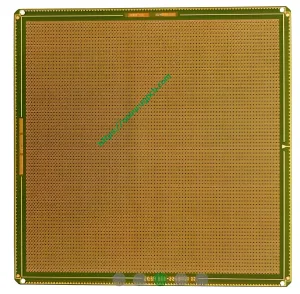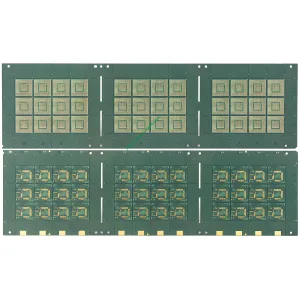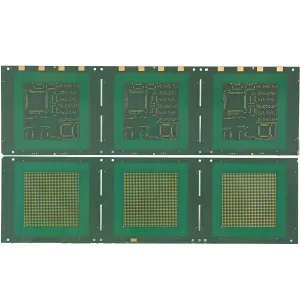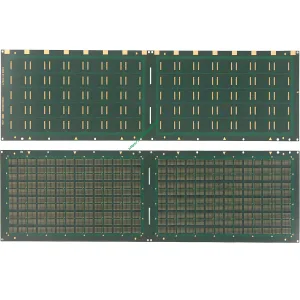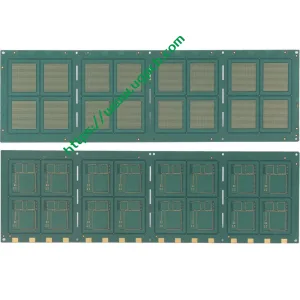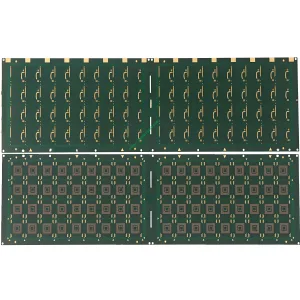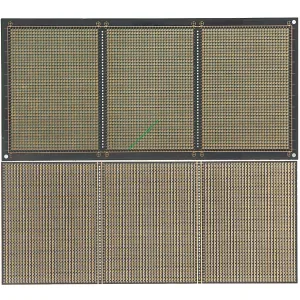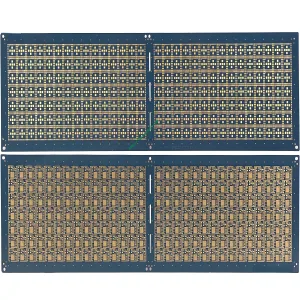1. Технология микропроводки реализует линию/пространство 30/30 мкм.
2. Малый диаметр с помощью технологии лазерного формирования реализует проводку высокой плотности
3. Используйте терморевни -синтетическую смолу с превосходной надежностью
4. Соответствующая обработка поверхности (Является/или, Сак -паялка, и т. д.) может быть реализован в соответствии с требованиями к упаковке
5. Можно предоставить зеленые продукты, такие как без свинца и без фтора
С энергичным развитием новых IC, таких как BGA (Шариковая сетка массив) и CSP (Чип -шкала упаковка), IC -субстраты процветали, И этим ICS нужны новые упаковочные носители. Как одна из самых продвинутых ПХБ (печатные платы), PCB подложки IC, вместе с любым уровнем HDI PCB и гибкой жесткой печатной платой, имеет взрывной рост популярности и применения, и теперь широко используется в телекоммуникациях и электронных обновлениях.
Подложка IC - это субстрат, используемый для упаковки IC. (Интегрированная схема) чипсы. Подключение чипов и плат, IC - это промежуточный продукт со следующими функциями:
• Он захватывает чипсы с полупроводником;
• Внутренняя проводка для подключения чипа и печатной платы;
• Это может защитить, Укреплять и поддерживать чипсы IC и обеспечить туннели для рассеивания тепла.
Классификация субстрата IC
а. Классифицируется по типу пакета
• BGA IC Substrate. Этот IC -субстрат работает хорошо с точки зрения рассеяния тепла и электрических характеристик, и может значительно увеличить штифты чипа. Поэтому, он подходит для пакетов IC с более чем 300 булавки.
• Подложка CSP IC. CSP - это один пакет чипсов, легкий вес, маленький размер, и аналогичный размеру IC. Субстраты IC CSP в основном используются в продуктах памяти, Телекоммуникационные продукты и электронные продукты с небольшим количеством булавок.
• FC IC Substrate. Фк (Flip Chip) это пакет, который переворачивает чип, с низким вмешательством сигнала, Низкая потеря цепи, Хорошая производительность и эффективная рассеяние тепла.
• Substrate MCM IC. MCM-это аббревиатура многоцветного модуля. Этот тип субстрата IC поглощает чипы с разными функциями в одну упаковку. Поэтому, Из -за его характеристик, включая легкость, худость, Отказ и миниатюризация, Этот продукт может быть лучшим решением. Конечно, Поскольку несколько чипов упакованы в одном пакете, Этот тип субстрата не работает хорошо с точки зрения вмешательства сигнала, рассеивание тепла, и прекрасная проводка.
б. Классифицируется по свойствам материала
• Жесткий IC -субстрат. Это в основном из эпоксидной смолы, Смола BT или смола ABF. Его CTE (Коэффициент термического расширения) около 13 к 17 ppm/° C.. • Flex IC Substrate. Он в основном сделан из Pi или PE RIN и имеет CTE 13 до 27 ppm/° C • керамический IC Substrate. В основном изготовлен из керамических материалов, такие как оксид алюминия, алюминиевый нитрид или карбид кремния. У него относительно низкий CTE, о 6 до 8 частей на час/° C.
в. Классификация с помощью технологии связывания
• проволочная связь
• Таб (Автоматическое клавиш)
• Связь ФК
Применение IC Substrate PCB
IC Substrate PCB в основном используется в легком весах, легкие и мощные электронные продукты, такие как смартфоны, ноутбук компьютеров, планшетные компьютеры и сети, такие как телекоммуникации, медицинское лечение, промышленный контроль, аэрокосмические и военные поля.
Жесткая печатная плата проходит через многослойную печатную плату, Традиционная HDI PCB, SLP (подложка, подобная печатной плате) на серию инновационных субстратных ПХБ IC. SLP - это просто жесткая печатная плата, и его производственный процесс похож на полупроводниковую шкалу.
Трудности в производстве PCB подложки IC
По сравнению со стандартными печатными платами, Субстраты IC должны преодолеть трудности высокоэффективных и передовых функций в производстве.
Подложка IC тонкий и легко деформируется, особенно когда толщина доски меньше, чем 0.2 мм. Преодолеть эту трудность, Прорывы должны быть сделаны в усадке доски, Параметры ламинирования и системы позиционирования слоя для эффективного управления подложкой и толщиной ламинирования и толщины ламинирования.
 ЛОГОТИП УГКПБ
ЛОГОТИП УГКПБ


